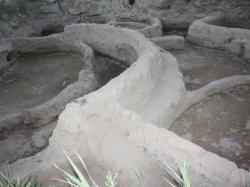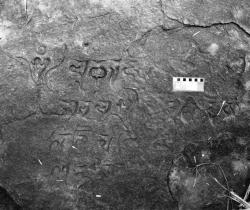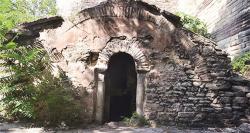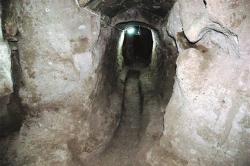INSTITUT SUPERIEUR D'ANTHROPOLOGIE
INSTITUTE OF ANTHROPOLOGY
ONLINE COURSES / COURS A DISTANCE
FALL TERM : OCTOBER 2014
REGISTER NOW
AZERBAIDJAN –  Mahta - Azerbaijani archaeologists discovered new finds in the ancient settlement of Mahta I, located on the territory of Sharur region of the Nakhchivan Autonomous Republic (NAR), head of the department at the Institute of Archaeology and Ethnography of the Azerbaijani National Academy of Sciences (ANAS) Safar Ashurov told Trend Aug. 23. "The archaeologists discover the finds referring to the Early Bronze Age in the territory of the ancient settlement of Mahta I," he added. Ashurov said that the excavations were conducted in an area of 300 square meters and the layer was examined at a depth of up to three meters. "The ruins of two circular stone structures were found during excavations," Ashurov added. "An ash layer was discovered inside of one of these circular structures," he said. "It is 30-40 cm thick. This testifies to the fact that the structure had a domed wooden roof." "Pottery was presented by simple and colorful dishes during that era," he said. "The red paint used in one of the dishes testifies to this. A variety of stone items discovered during excavations, especially tools for threshing grain, testifies to the fact that the population was mainly engaged in agriculture during that period and had a sedentary lifestyle. Each construction in the ancient settlement had its own specific function."
Mahta - Azerbaijani archaeologists discovered new finds in the ancient settlement of Mahta I, located on the territory of Sharur region of the Nakhchivan Autonomous Republic (NAR), head of the department at the Institute of Archaeology and Ethnography of the Azerbaijani National Academy of Sciences (ANAS) Safar Ashurov told Trend Aug. 23. "The archaeologists discover the finds referring to the Early Bronze Age in the territory of the ancient settlement of Mahta I," he added. Ashurov said that the excavations were conducted in an area of 300 square meters and the layer was examined at a depth of up to three meters. "The ruins of two circular stone structures were found during excavations," Ashurov added. "An ash layer was discovered inside of one of these circular structures," he said. "It is 30-40 cm thick. This testifies to the fact that the structure had a domed wooden roof." "Pottery was presented by simple and colorful dishes during that era," he said. "The red paint used in one of the dishes testifies to this. A variety of stone items discovered during excavations, especially tools for threshing grain, testifies to the fact that the population was mainly engaged in agriculture during that period and had a sedentary lifestyle. Each construction in the ancient settlement had its own specific function."
http://en.trend.az/news/society/2304735.html?
INDE –  Dhuluri - Archaeologists from the University of Calcutta have found an 8th Century inscription in a village in West Bengal’s Purulia district. The inscription running into four lines was found from Dhuluri village on the corner of a long stretch of rock surface surrounded by dense vegetation and beyond the habited area of the village, Rajat Sanyal, Assistant Professor of the Department of Archaeology, University of Calcutta, told The Hindu. The rock is located in the Saturi block of the district on the banks of a local rivulet emerging from river Damodar. “A study of the characteristic features of the inscription suggests that the short epigraph is carved in an unusual and extremely calligraphic Siddhamatrka script. The only other example of such an inscription is datable to the 6th Century [C.E.] and found in the Sushnia hills in adjoining Bankura district,” he added. So far the archaeologists have only been able to decipher one line of the inscription that reads ‘sriyuvaraja’ which may be referring to a crown prince. “The first line has been deciphered with help from Professor Arlo Griffiths [an Indology expert] and efforts are on complete its decipherment,” Prof Sanyal said. “This is the earliest dated inscription found in Purulia region and once completely deciphered it can shed new light on the early- medieval history of the region,” said Bishnupriya Basak, assistant professor of the Department of Archaeology, University of Calcutta. The inscription was actually spotted by a local school teacher, Madhab Mondal, who informed the block development officer, Saturi Dibyendu Sekhar Das. Mr. Das informed the archaeologist team that visited the village. As the rock surface containing the inscription is fast decaying, archaeologists have urged local authorities to take measures for its preservation. The rock surface spans over 200 metres but the inscription covers only about a feet and cannot be removed. Within the Dhuluri village, the archaeologists have also spotted ruins of an ancient stone temple and many stone sculptures from apparently the same historical period.
Dhuluri - Archaeologists from the University of Calcutta have found an 8th Century inscription in a village in West Bengal’s Purulia district. The inscription running into four lines was found from Dhuluri village on the corner of a long stretch of rock surface surrounded by dense vegetation and beyond the habited area of the village, Rajat Sanyal, Assistant Professor of the Department of Archaeology, University of Calcutta, told The Hindu. The rock is located in the Saturi block of the district on the banks of a local rivulet emerging from river Damodar. “A study of the characteristic features of the inscription suggests that the short epigraph is carved in an unusual and extremely calligraphic Siddhamatrka script. The only other example of such an inscription is datable to the 6th Century [C.E.] and found in the Sushnia hills in adjoining Bankura district,” he added. So far the archaeologists have only been able to decipher one line of the inscription that reads ‘sriyuvaraja’ which may be referring to a crown prince. “The first line has been deciphered with help from Professor Arlo Griffiths [an Indology expert] and efforts are on complete its decipherment,” Prof Sanyal said. “This is the earliest dated inscription found in Purulia region and once completely deciphered it can shed new light on the early- medieval history of the region,” said Bishnupriya Basak, assistant professor of the Department of Archaeology, University of Calcutta. The inscription was actually spotted by a local school teacher, Madhab Mondal, who informed the block development officer, Saturi Dibyendu Sekhar Das. Mr. Das informed the archaeologist team that visited the village. As the rock surface containing the inscription is fast decaying, archaeologists have urged local authorities to take measures for its preservation. The rock surface spans over 200 metres but the inscription covers only about a feet and cannot be removed. Within the Dhuluri village, the archaeologists have also spotted ruins of an ancient stone temple and many stone sculptures from apparently the same historical period.
http://www.thehindu.com/news/cities/kolkata/8th-century-inscription-found-in-purulia-village/article6344656.ece
TURQUIE –  Silivrikapı - To the left of the Silivrikapı Walls in Istanbul’s Fatih neighborhood, there lies a tomb from the fourth century A.D., which is now in ruins. Known as the Silivri Crypt, the tomb, which has been suffering since its discovery in 1988, is now in its worst state. The Silivrikapı Crypt, which was found by Professor Ümit Serdaroğlu, dates back to the fourth century A.D. at the time of the eastern Roman Emperor Theodosius. The tomb was restored in 1989 by the Istanbul Municipality but has been looted many times since its restoration. The reliefs that cover the crypt were stolen in 1993, only to be rediscovered and given to the Istanbul Museum of Archeology. The frescoes which were also restored were damaged over time. The historical Byzantine tomb is now no different than a junkyard.There are many historical artifacts like the crypt in the area. It is thought that they were all part of the necropolis before the reign of Theodosius II.
Silivrikapı - To the left of the Silivrikapı Walls in Istanbul’s Fatih neighborhood, there lies a tomb from the fourth century A.D., which is now in ruins. Known as the Silivri Crypt, the tomb, which has been suffering since its discovery in 1988, is now in its worst state. The Silivrikapı Crypt, which was found by Professor Ümit Serdaroğlu, dates back to the fourth century A.D. at the time of the eastern Roman Emperor Theodosius. The tomb was restored in 1989 by the Istanbul Municipality but has been looted many times since its restoration. The reliefs that cover the crypt were stolen in 1993, only to be rediscovered and given to the Istanbul Museum of Archeology. The frescoes which were also restored were damaged over time. The historical Byzantine tomb is now no different than a junkyard.There are many historical artifacts like the crypt in the area. It is thought that they were all part of the necropolis before the reign of Theodosius II.
http://www.hurriyetdailynews.com/byzantium-king-tomb-turning-into-garbage-dump.aspx?PageID=238&NID=70772&NewsCatID=375
CHINE – Xi'an - Archaeologists said Saturday they have discovered a tomb with well preserved wall paintings, dating back more than 1,200 years, in northwest China's Shaanxi province. The Tang dynasty (618-907) tomb of a high ranking official and his wife in Chang'an district, Xi'an City, is 11 metres deep and about 40 metres long, said Zhao Rong, head of Shaanxi Cultural Heritage Administration. The grave had been raided by robbers. The murals in the chamber show great skill, Xinhua reported citing the official. Excavation began in February this year and cleaning work is still under way along with measures to protect the artwork, said Zhao. Xi'an, historically known as Chang'an, was the Chinese capital during the rule of several dynasties, including the Tang dynasty.
http://www.newindianexpress.com/world/1200-year-old-Tomb-Discovered-in-China/2014/08/23/article2394583.ece?
CUBA - Puerto Esperanza - Fishermen in Cuba's western Pinar del Rio province have discovered a cache of sunken artifacts believed to be from a 17th- or 18-century shipwreck, local daily reported on Friday. The "important marine archaeological find" was recently discovered off the coast of Puerto Esperanza, a town in northern Pinar del Rio, the daily Juventud Rebelde said. The find, which the daily said puts "the coasts of Pinar del Rio among the most historically relevant in regard to the pirate era," comprises some 60 artifacts, including firearms, cannon balls, swords and assault machetes, it added. "While it's important to point out that this is an interesting discovery, it's crucial to insist that such finds of historical value must remain and be preserved in their own setting," said Enrique Giniebra, a researcher and member of Cuba's Naval Maritime Historical Group. The coasts around the province are littered with shipwrecks dating from the age of pirates on the high seas, said Juan Carlos Rodriguez, another member of the group. This particular find is considered as the most important to date in the province.
http://www.china.org.cn/world/2014-08/23/content_33318362.htm?
INDE - Vaishali - As clamour grows for bringing back a 400-kg greenish-grey granite bowl kept at a museum in Afghanistan, the Archaeological Survey of India (ASI) is struggling to find a “conclusive proof” that it, indeed, is the begging bowl of Gautama Buddha made in the 6th century BC at Vaishali district of Bihar. G S Khwaja, Director ASI’s Epigraphy Branch in Nagpur, who visited the National Museum of Afghanistan in Kabul along with Phani Kant Mishra, Director (Archeology), Kolkata, to examine the artefact in May, has concluded in his report that it did not seemed to be belonging to Lord Buddha. He noted that bowl bore a Persian inscription in Thulth style of Islamic calligraphy, dateable to the 15th or 16th century AD, and there was no other writing in Pali or Sanskrit inscribed on it. In his report, Khwaja also underlined that there was no indication of Persian inscription overwritten on the artefact, suggesting that the belief that it belonged to the Buddha could be a case of “mistaken identity”.
http://www.deccanherald.com/content/427065/asi-raises-doubts-039buddha-bowl039.html?
TURQUIE –  Ağırnas - A man in the Central Anatolian province of Kayseri’s Melikgazi district has discovered an extensive underground structure while cleaning a house that he inherited from his family. The house in the Ağırnas neighborhood, where the famous Ottoman architect Sinan lived, was bequeathed Bozdemir, who is living in France, five years ago. He came to see the house at the time and discovered the underground city when cleaning the house. He informed the Kayseri Governor’s Office and the Culture and Tourism Directorate. Examinations showed that the house probably dated back to the Roman era. With necessary permissions, Bozdemir continued excavations to completely unearth the underground city. “When restoring the house, I decided to clean the lower floors. As we cleaned it, we reached four more floors under the house. It was a single-floor house but it was five-stories. Nearly 80 percent of the excavations have been completed. The soil was removed manually and 10 people worked for the cleaning of an area of 2,500 sqaure meters. We also found some remains during the cleaning works such as human bones. They were examined by a team from Erciyes University,” he said, adding that he would allow tourists to visit the underground city.
Ağırnas - A man in the Central Anatolian province of Kayseri’s Melikgazi district has discovered an extensive underground structure while cleaning a house that he inherited from his family. The house in the Ağırnas neighborhood, where the famous Ottoman architect Sinan lived, was bequeathed Bozdemir, who is living in France, five years ago. He came to see the house at the time and discovered the underground city when cleaning the house. He informed the Kayseri Governor’s Office and the Culture and Tourism Directorate. Examinations showed that the house probably dated back to the Roman era. With necessary permissions, Bozdemir continued excavations to completely unearth the underground city. “When restoring the house, I decided to clean the lower floors. As we cleaned it, we reached four more floors under the house. It was a single-floor house but it was five-stories. Nearly 80 percent of the excavations have been completed. The soil was removed manually and 10 people worked for the cleaning of an area of 2,500 sqaure meters. We also found some remains during the cleaning works such as human bones. They were examined by a team from Erciyes University,” he said, adding that he would allow tourists to visit the underground city.
http://www.hurriyetdailynews.com/man-discovers-underground-structure-while-cleaning-house-in-central-anatolia.aspx?pageID=238&nid=70834&NewsCatID=375